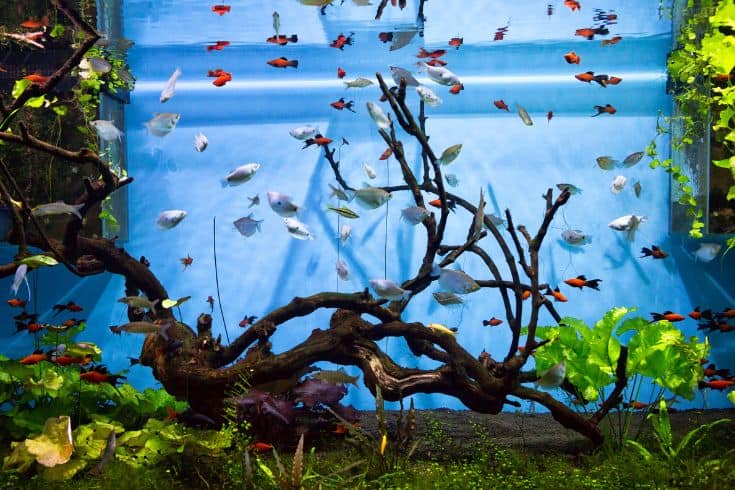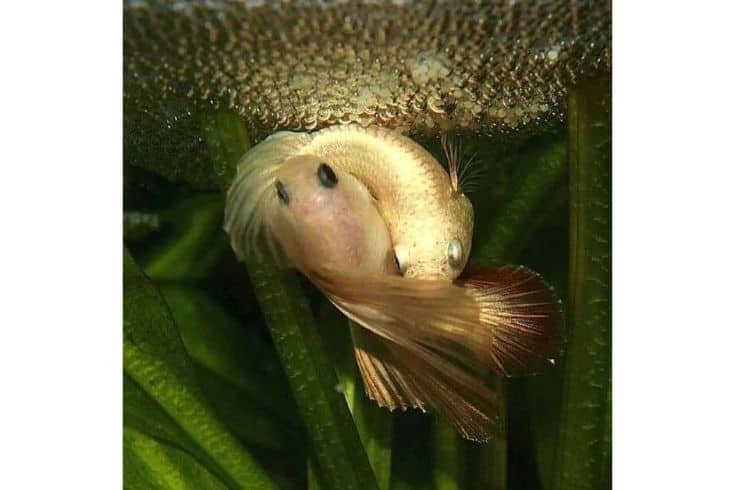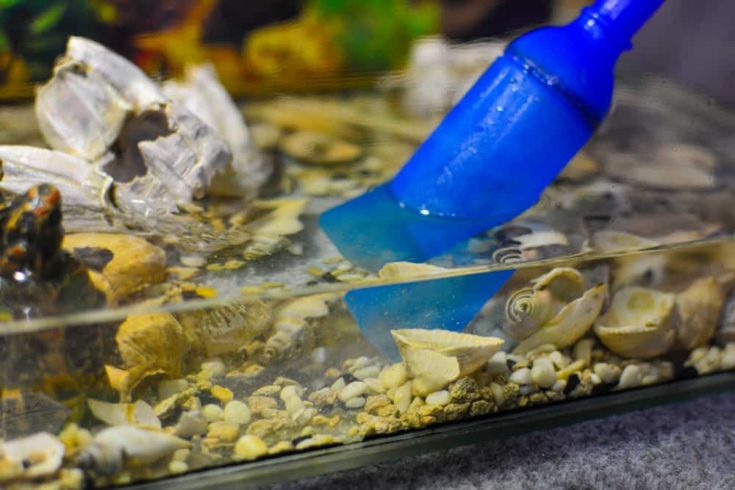Double tail bettas are one of the most popular fish in the aquarium trade with their distinct tails and vibrant colors. While their unique appearance is certainly eye-catching, these fish are also relatively easy to care for and make great additions to both beginner and experienced aquarists alike.
This article will discuss everything you need to know about caring for your double tail betta, including their lifespan, diet, tank mates, and more! Whether you’re thinking about adding one of these beautiful fish to your aquarium or are simply curious about them, read on to learn all there is to know about double tail bettas.
Characteristics/Appearance/LifeSpan
Common Name (species)
Double Tail Betta Fish, Twin Tail Betta, Siamese Fighting Fish (Generic)
Family
Osphronemidae
Origin
Southeast Asia
Diet
Omnivore
Care Level
Easy
Activity
Active, social, alert
Temperament
Aggressive
Tank Level
Top
Minimum Tank Size
5 Gallons
Temperature Range
72 – 80 degrees Fahrenheit
Water Hardness
5 – 20 dH
pH Range
6.5 – 7.5
Filtration/Flow Rate
Calm
Breeding
Egg layer
Compatibility
Similarly-sized community fish
OK, for Planted Tanks?
Yes, but plants should have smooth edges
What Do Double Tail Betta Fish Look Like?
The double tail betta is a sub-variety of betta splendens, or Siamese fighting fish. These fish are named for their unique caudal tail type, characterized by two distinct lobes resembling separate tails. Double tail bettas come in a wide range of colors and patterns, including solid colors like blue or red and more complex patterns like marble or butterfly.
Although the double tail gene is considered a naturally occurring mutation, it has been selectively bred by aquarists in recent years to create fish with a more pronounced split tail. Many of these beautiful fish have shorter bodies and fins than their single-tail counterparts, although there is some variation in size and shape between different breeding lines.
How Long Do Double Tail Betta Fish Live?
In general, the double tail variety of betta splendens is just as hardy and easy to care for as other betta sub-types. When provided with proper care, these fish can live for 3-5 years, although some individuals have been known to live for much longer.
Suppose you’re interested in keeping a double tail betta fish as a pet. In that case, it’s important to be aware that these fish have relatively short lifespans compared to other common aquarium fish. Couple this with the fact that double tail bettas cost more than their single tail counterparts, and it’s clear that these fish are best suited for experienced hobbyists who are prepared to commit to long-term care.
Temperament and Tankmates

Double tail bettas are perfect for beginner fish keepers, because they are active fish that can get along with other non-aggressive schooling fish. Although many people have the misconception that they prefer to live as solitary fish in a solo tank, double tail bettas are social fish that do best when kept in small groups.
While it is true that this breed of fish is known for being aggressive towards other betta fish, they can coexist peacefully with other non-betta species. When choosing tank mates for your double tail betta, it’s important to select docile fish that are a similar size and have peaceful temperaments. Good choices for tank mates include:
- Guppies
- Platies
- Mollies
- Swordtails
It’s also important to ensure that your aquarium is large enough to accommodate both your double tail betta and their tank mates. As a general rule of thumb, you should have at 1 gallon of water per inch of fish.
What Do Double Tail Bettas Eat?
It takes a ton of nutritious food to keep gorgeous fish like double tail bettas healthy and happy. Thankfully, these fish are pretty easy to please! Double tail bettas feed on small insects and zooplankton in the wild. In captivity, they can be fed a variety of fish food and fish flakes. To ensure a well-rounded diet, we recommend feeding your fish a mix of the following:
- Bloodworms
- Brine shrimp
- Daphnia
- Krill
You should also supplement your fish’s diet with high-quality flakes or pellets designed specifically for betta fish. These pellets contain all of the nutrients and vitamins your fish need to stay healthy, including protein, fat, fiber, and carotene.

To avoid overfeeding, only give your fish as much food as they can eat in one sitting. A good rule of thumb is to give them enough food for them to consume in 2-3 minutes. If you’re unsure how much food to give them, it’s always better to avoid giving them less.
Common Health Issues
Now that you know a little bit more about double tail bettas, it’s time to learn about some of the most common health problems affecting these fish. By familiarizing yourself with the signs and symptoms of these diseases, you’ll be better equipped to identify and treat them quickly if they occur.
Ripped Fins
Double tail bettas have heavy tails that are prone to tearing. If you notice that your fish’s fins are frayed or ripped, it’s important to take action immediately. Ripped fins can lead to serious health problems, including infections, if they are not treated immediately.
To prevent ripped fins, it’s important to ensure that your fish has plenty of open space to swim and that there are no sharp objects in their tank that they could potentially hurt themselves on. You should also avoid keeping your betta with fish that are known to nip at fins, such as goldfish or tiger barbs.
Ich
Like most freshwater fish, double tail bettas are susceptible to ich caused by a parasitic infestation. Ich is one of the most common diseases in aquarium fish, and it can be fatal if it is not treated immediately. The most common symptoms of ich include:
- White spots on the skin
- Flashing or rubbing against objects in the tank
- Loss of appetite
- Listlessness
If you notice any of these symptoms in your fish, it’s important to take them to a vet as soon as possible. Ich can be treated with various medications, including copper sulfate and formalin.
Velvet disease
Velvet disease is another common ailment that can affect double tail bettas. The most distinctive symptom of velvet disease is a dusty, yellow film that covers the fish’s body. This “gold dust” is caused by a type of parasitic algae that can quickly kill your fish if it is not treated immediately.
In addition to the yellow film, fish with velvet disease may rub against objects in the tank. Picture this – your beautiful betta is floating peacefully one minute, and the next they’re frantically swimming around and scratching their body on the gravel. If you notice this behavior, it’s a surefire sign that your fish has velvet disease and needs to be treated immediately.
These are just some of the most common health problems that can affect double tail bettas. To learn more about how to keep your fish healthy and happy, be sure to check out our care guides.
Breeding Your Double Tail Betta
Have we piqued your interest in breeding double-tail bettas? With their vast variety of colors and patterns, it’s no wonder that these fish are so popular among breeders. If you’re thinking about breeding your own double tail bettas, there are a few things you should know first.
Selecting The Right Parents
First and foremost, you’ll need to purchase a pair of high-quality fish from a reputable breeder. It’s important to avoid purchasing fish from pet stores, as they are often inbred and unhealthy. A good breeder can provide you with healthy fish with the desired traits you’re looking for.

Before you start breeding your fish, it’s important to make sure that they are in the best possible health. This means feeding them a high-quality diet and providing them with plenty of clean water. You should also quarantine any new fish before adding them to your breeding tank to ensure that they are not carrying any diseases or parasites.
Getting Ready To Breed
When you’re ready to breed your fish, you’ll need to set up a breeding tank. The tank should be at least 10 gallons and should be equipped with a filter and heater. It’s also a good idea to add a layer of gravel to the bottom of the tank.
To induce spawning, you’ll need to raise the water temperature to around 80 degrees Fahrenheit. You can do this by placing an aquarium heater in the breeding tank. Once the water has reached the desired temperature, you should add a few live plants to the tank. The plants will provide your fish with hiding places and help to oxygenate the water.
Spawning
You can introduce your pair of double tail bettas to the breeding tank when everything is set up and ready to go. If all goes well, they will start to spawn within a few hours. The female fish will lay hundreds of eggs, which will sink to the bottom of the tank and attach themselves to the plants or gravel.
Once the eggs have been laid, removing the parents from the tank is important. This is because they will likely eat their eggs if given the chance. If you want to increase the chances of your eggs surviving, you can place them in a separate incubation tank.
Egg Hatching
To hatch the eggs, you’ll need to maintain a water temperature of 80 degrees Fahrenheit and keep the water well-oxygenated. After about three days, the eggs should start to hatch and you’ll see tiny fry swimming around in the tank.
At this point, you’ll need to start feeding them baby brine shrimp or other small live foods. It’s important to avoid overfeeding the fry, as this can cause them to become sick. You should also perform regular water changes to keep the tank clean and free of harmful toxins.
As the fry grow bigger, you can start feeding them pellets or flakes. After a few months, they should be big enough to be moved into their tanks. And that’s it! With a little patience and perseverance, you’ll be able to successfully breed your double tail bettas.
Double Tail Betta Fish Tank Requirements
Now that you know how to care for your double tail betta, it’s time to set up their tank. This section will give you all the necessary information to get started, including the recommended tank size and water parameters.
Tanks Should Be Frequently Maintained
Water cleanliness and quality are extremely important for the health of your fish. You don’t want to wait until the water starts to look dirty before you take action, as this can put your fish at risk of developing infections or diseases. To avoid this, it’s important to perform regular water changes and clean the tank regularly.

Investing in a good filter is one of the best ways to keep your tank clean. Filters help to remove harmful toxins and debris from the water, making it easier to maintain clean water conditions. It’s also a good idea to add live plants to your tank. Plants help to oxygenate the water and provide hiding places for your fish.
Choose An Appropriately-Sized Tank
When it comes to tank size, you’ll need to choose a size that’s appropriate for the number of fish you plan on keeping. For a single double tail betta, a 5-gallon tank is the minimum tank size recommendation. If you plan on keeping more than one fish, you’ll need a larger tank.
It’s important to remember that bettas need plenty of space to swim, so choosing a tank that’s too small will limit their ability to move around and could lead to health problems. If you’re not sure what size tank to get, it’s always better to err on the side of caution and choose a larger tank.
Ensure That Water Parameters Are Ideal
Betta splendens hail from the sunny tropics of Southeast Asia, so they’re used to living in warm water. Tropical waters have a temperature range of 76 to 82 degrees Fahrenheit, so you’ll need to maintain similar water conditions in their tank.

The recommended pH range for betta tanks is 6.5 to 7.5, and the recommended hardness range is 5 to 15 dGH. It’s important to regularly test the water in your tank to ensure that these parameters are within the ideal range. If they’re not, you can use a water conditioner to adjust the water conditions accordingly.
In addition to temperature and pH, you’ll also need to keep the water in your tank well-oxygenated. Bettas are known for their elaborate fins, which makes them especially susceptible to fin rot and other infections. To avoid this, you’ll need to make sure that the water in their tank is properly aerated. We will cover some of the equipment you’ll need to do this in the next section.
What Else Do You Need For A Betta Tank? Product Recommendations
Now that you know what’s required for a betta tank, it’s time to start setting up your fish’s new home. This section will give you some product recommendations to get you started.
- Aerators: This equipment helps to oxygenate the water in your tank. We recommend the Tetra Whisper Air Pump. This air pump creates a water current while simultaneously aerating the water, making it ideal for betta tanks.
- Filter: As we mentioned earlier, filters help to remove toxins and debris from the water, making it easier for you to maintain clean water conditions. We recommend the Marineland Penguin Power Filter, which does an amazing job of keeping the water clean without creating heavy water movement.
- Heater: Bettas are tropical fish that need a warm water temperature to thrive. We recommend the Tetra HT Submersible Aquarium Heater, which is an affordable and easy-to-use heater that will help you maintain the ideal water temperature for your fish.
Now that you know what’s required for a betta tank, it’s time to start setting up your fish’s new home!
Setting Up A Double Tail Betta Tank
What goes into setting up a double tail betta tank? This section will give you a quick overview of the process and some helpful tips.
To start, you’ll need to choose a tank size that’s appropriate for the betta. Then, cycle the tank and add the appropriate amount of water conditioner. Once the water is conditioned, you can add your live plants and decorations.
Leave the tank to settle for 24 hours before adding your fish. When you’re ready to add your fish, do so slowly and carefully. After adding your fish, monitor the water closely for the next few days to make sure that everything is going well.
There’s more to setting up a betta tank than what we can cover in this article, but these tips should give you a good starting point. For more information, check out this article!
The Takeaway
Double tail betta fish are some of the most delightful fish you can keep as a pet. They are relatively easy to care for, provided that you provide them with a spacious and well-maintained tank. Your double tail betta fish can live for several years with the proper care.
Do you have a double tail betta fish? We’d love to hear about your experiences in the comments below!
